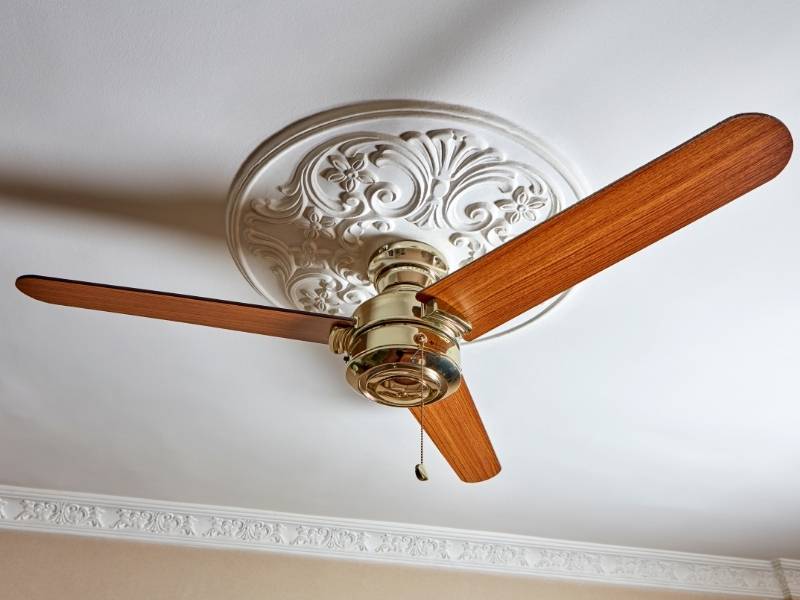Replacing a light fixture with a ceiling fan is a pretty easy DIY job that most homeowners can do in an afternoon. But, like any job, it can be tricky. Stuff can come up during the installation process that you didn’t anticipate, or that isn’t mentioned in the YouTube video you watched about it.
Fortunately, this path has been forged by many other homeowners and home improvement experts, and they’ve shared what they’ve learned with the world, so you can overcome obstacles that might arise while you’re replacing your light fixture with a ceiling fan. Here are some of the most important things to keep in mind while you’re doing the job.
How to Replace Your Light Fixture with a Ceiling Fan

1. Patch an Old Light Fixture Hole with a Ceiling Medallion
Light fixtures aren’t that heavy. In fact, with the exception of large chandeliers and some sconces, most weigh only a few pounds. That means a light fixture will hang from a standard electrical box. However, you must switch to a fan-rated box to hang a ceiling fan, which weighs 50 pounds or more.
Replacing a standard electrical box with a fan-rated box meana shifting the fixture placement to one side or the other so you can affix the fan-rated electrical box to a brace or joist.
That leaves you with an unsightly hole in your ceiling. But, don’t worry. After you install the electrical box and before wiring up the fan, place a ceiling medallion around the new electrical box. Make it large enough to cover the old hole left by the fan for an attractive look.
2. Use the Installation Hook on the Fan Motor
When you install your ceiling fan, you might wonder if you need help holding the fan up while you connect the wiring. However, most ceiling fans have an installation hook on the fan motor. Its purpose is to hold the fan in place at the ceiling level while you do the wiring work. Therefore, it’s easy to hook it to the electrical box, freeing up your hands to connect the wiring. So, when you’re ready, just swing the fan motor up into place and mount it to the electrical box.
3. Wire the Fan Motor and Lights Separately
When you install your ceiling fan, you first connect the wiring from the fan motor to the wiring from your house. You do this the same way your light fixture was connected, which is black wires connect to black wires, white wires connect to white wires, and green or bare ground wires connect to each other and the electrical box. There must also be a grounding screw to attach them together. Next, secure the wiring connections with wiring nuts, then mount the fan motor to the electrical box.
If your fan has a light fixture, then, wire up the lights in a separate step. You will see wires coming out of your fan motor that connect to the wiring in the lights. So, you simply wire it up just like you did the fan motor, and attach the light fixture to the fan motor.
4. Make Sure the Fan Is Mounted to a Sturdy Brace
As mentioned above, ceiling fans are heavy, so you need to make sure to mount yours to a sturdy brace or directly to a ceiling joist. If you have access to the joists from above, such as from an attic, you can install a two-by-four between the joists with two- to three-inch decking screws. This will provide a stable, sturdy brace to support your new fan’s weight.
If you can’t access your ceiling joists from above, you can buy expanding metal braces that you can insert through the hold and expand from below. Spikes on the ends will dig into the joists, stabilizing the brace. Then you can mount your fan-rated electrical box to the metal brace.
5. Choose the Right Size Fan for Your Room
A fan that is too small won’t produce the breezes want. On the other hand, a fan that is too big will take over the room. Also, fan that hangs too low could present a hazard. Additionally, if you mount a fant too close to the ceiling, it won’t be able to move air effectively.
Fans come in a range of different sizes with different extension rods for various ceiling heights. Know the size of your room and the height of your ceiling, and do your research to make sure you’re getting the right fan size.
Replacing a light fixture with a ceiling fan can really raise the comfort level of your home, but be ready to address any problems that arise. Soon, you’ll be enjoying a refreshing breeze even on the hottest summer’s day.
If you have any other questions or suggestions, please leave them in the comments. Also, you will see several links below to take you to more excellent articles about all things design.
Images Courtesy of Canva.
Other Posts You Might Enjoy:
Home Upgrades that will Benefit your Everyday Life
Lighting Every Room In Your Home Beautifully
How To Add Roofing In Your Outdoor Area Without Entirely Closing The Space
Unique Ceiling Fan Design Ideas That’ll Inspire Your Creativity





